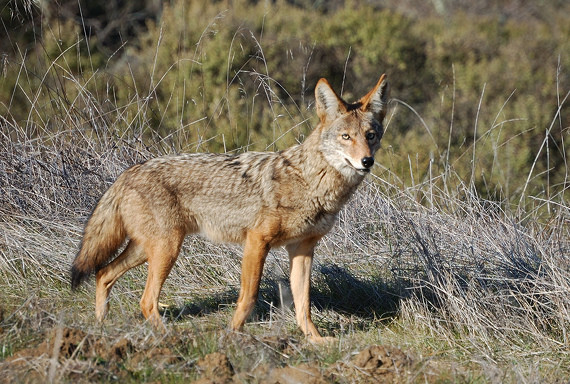Post by dinosauria101 on Aug 30, 2019 15:44:33 GMT 5
Grey Wolf - Canis lupus
The Grey Wolf (Canis lupus) is the largest wild canid, males averaging between 70 and 110 pounds depending on subspecies. The Wolf has a specialized body that has made it one of the world's most efficient hunters. Its powerful neck is a very important adaptation: it has to be strong to support the wolf's large head and is crucial for bringing down prey. The skull is 31cm (12 inches) long and is armed with an impressive array of large canines and carnassial teeth which, when coupled with huge jaw muscles that are evident from the large sagittal crest and wide zygomatic arches, give it an incredible biteforce that is strong enough to break the bones of prey and even crack the femur of moose. Wolves primarily feed on medium to large sized ungulates (up to the size of bison 10–15 times larger than themselves), though they are not fussy eaters. Medium and small sized animals that may supplement the diet of wolves include marmots, beaver, hares, badgers, foxes, weasels, ground squirrels, mice, hamsters, voles and other rodents, as well as insectivores.

Coyote (pack of 4) - Canis latrans
The coyote (Canis latrans), also known as the American jackal or the prairie wolf, is a species of canine found throughout North and Central America, ranging from Panama in the south, north through Mexico, the United States and Canada. It occurs as far north as Alaska and all but the northernmost portions of Canada. The color of the coyote's pelt varies from grayish-brown to yellowish-gray on the upper parts, while the throat and belly tend to have a buff or white color. The forelegs, sides of the head, muzzle and paws are reddish-brown. The back has tawny-colored underfur and long, black-tipped guard hairs that form a black dorsal stripe and a dark cross on the shoulder area. The black-tipped tail has a scent gland located on its dorsal base. Coyotes shed once a year, beginning in May with light hair loss, ending in July after heavy shedding. The ears are proportionately large in relation to the head, while the feet are relatively small in relation to the rest of the body. Certain experts have noted the shape of a domestic dog's brain case is closer to the coyote's in shape than that of a wolf's. Mountain-dwelling coyotes tend to be dark-furred, while desert coyotes tend to be more light brown in color. Coyotes typically grow to 30–34 in (76–86 cm) in length, not counting a tail of 12–16 in (30–41 cm), stand about 23–26 in (58–66 cm) at the shoulder and, on average, weigh from 15–46 lb (6.8–21 kg). Northern coyotes are typically larger than southern subspecies, with the largest coyotes on record weighing 74.75 pounds (33.91 kg) and measuring 1.75 m (5.7 ft) in total length.

Credit to Wikipedia
The Grey Wolf (Canis lupus) is the largest wild canid, males averaging between 70 and 110 pounds depending on subspecies. The Wolf has a specialized body that has made it one of the world's most efficient hunters. Its powerful neck is a very important adaptation: it has to be strong to support the wolf's large head and is crucial for bringing down prey. The skull is 31cm (12 inches) long and is armed with an impressive array of large canines and carnassial teeth which, when coupled with huge jaw muscles that are evident from the large sagittal crest and wide zygomatic arches, give it an incredible biteforce that is strong enough to break the bones of prey and even crack the femur of moose. Wolves primarily feed on medium to large sized ungulates (up to the size of bison 10–15 times larger than themselves), though they are not fussy eaters. Medium and small sized animals that may supplement the diet of wolves include marmots, beaver, hares, badgers, foxes, weasels, ground squirrels, mice, hamsters, voles and other rodents, as well as insectivores.

Coyote (pack of 4) - Canis latrans
The coyote (Canis latrans), also known as the American jackal or the prairie wolf, is a species of canine found throughout North and Central America, ranging from Panama in the south, north through Mexico, the United States and Canada. It occurs as far north as Alaska and all but the northernmost portions of Canada. The color of the coyote's pelt varies from grayish-brown to yellowish-gray on the upper parts, while the throat and belly tend to have a buff or white color. The forelegs, sides of the head, muzzle and paws are reddish-brown. The back has tawny-colored underfur and long, black-tipped guard hairs that form a black dorsal stripe and a dark cross on the shoulder area. The black-tipped tail has a scent gland located on its dorsal base. Coyotes shed once a year, beginning in May with light hair loss, ending in July after heavy shedding. The ears are proportionately large in relation to the head, while the feet are relatively small in relation to the rest of the body. Certain experts have noted the shape of a domestic dog's brain case is closer to the coyote's in shape than that of a wolf's. Mountain-dwelling coyotes tend to be dark-furred, while desert coyotes tend to be more light brown in color. Coyotes typically grow to 30–34 in (76–86 cm) in length, not counting a tail of 12–16 in (30–41 cm), stand about 23–26 in (58–66 cm) at the shoulder and, on average, weigh from 15–46 lb (6.8–21 kg). Northern coyotes are typically larger than southern subspecies, with the largest coyotes on record weighing 74.75 pounds (33.91 kg) and measuring 1.75 m (5.7 ft) in total length.

Credit to Wikipedia


